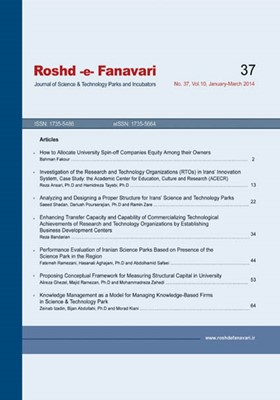-
-
List of Articles
-
Open Access Article
1 - How to Allocate University Spin-off Companies Equity Among their Owners
Bahman Facoor -
Open Access Article
2 - Investigation of the Research and Technology Organizations (RTOs) in Iran’s Innovation System: Case Study: the Academic Center for Education, Culture and Research (ACECR)
Reza Ansari Hamidreza Tayebi -
Open Access Article
3 - Analyzing and Designing a Proper Structure for Iran’s Science and Technology Parks
Saeed Shadan Daruosh Pourseragian Ramin Zareu -
Open Access Article
4 - Enhancing Transfer Capacity and Capability of Commercializing Technological Achievements of Research and Technology Organizations by Establishing Business Development Centers
Reza Bandarian -
Open Access Article
5 - Performance Evaluation of Iranian Science Parks Based on Presence of the Science Park in the Region
Fatemeh Ramezani Hassanali Aghajani Abdolhamid Safaei Ghadikalaei -
Open Access Article
6 - Proposing Conceptual Framework for Measuring Structural Capital in University
Alireza Ghezel Majid Ramezan Mohammad reza Zahedi -
Open Access Article
7 - Knowledge Management as a Model for Managing Knowledge-Based Firms in Science & Technology Park
Zinat Eizadian Bizhan Abdollahi Valimorad Kiani
-
The rights to this website are owned by the Raimag Press Management System.
Copyright © 2017-2025







